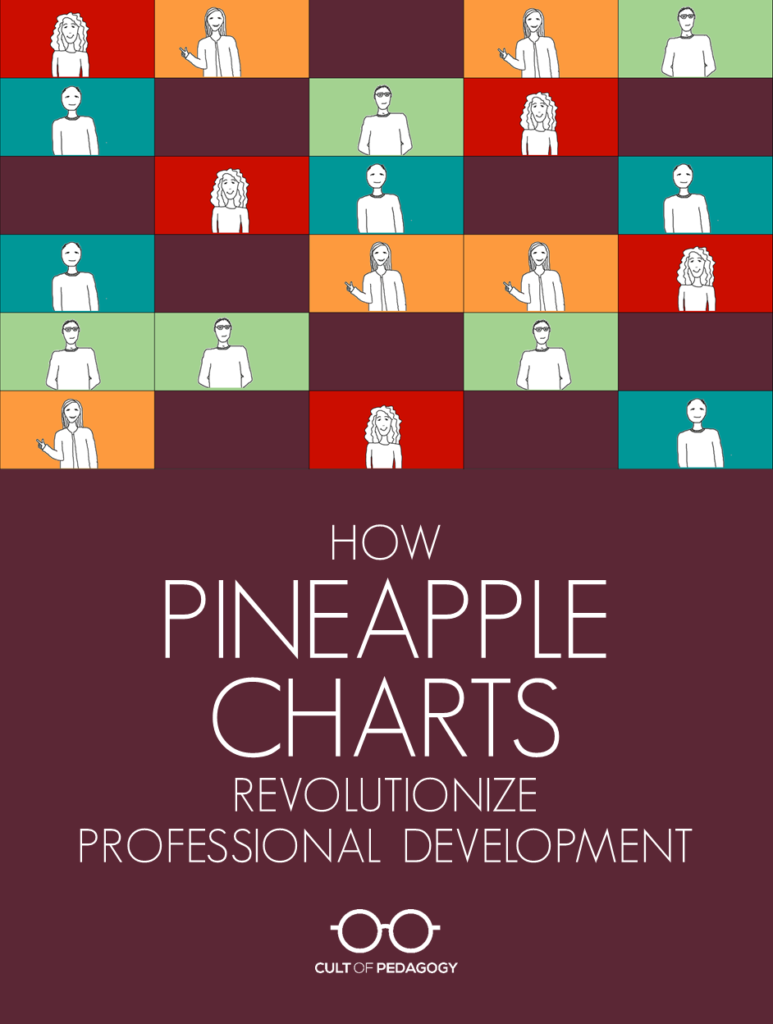
This post contains Amazon Affiliate links. If you click these and make a purchase from Amazon, I will receive a small commission at no extra cost to you. Thanks for your support.
Professional Development: The phrase has a way of striking dread into the hearts of teachers. But not because teachers don’t WANT to improve. Not because we believe we’re done growing and learning. Far from it.
In fact, so many teachers bristle at the thought of PD because most of the time, it’s executed so poorly. Although the typical one-size-fits-all format—where every teacher in the building is herded together to listen to an expert speak—has been widely denounced, it still persists as the default model. Sometimes, if the speaker happens to be engaging, some teachers will walk away with a small tidbit they can apply to their own work. For most teachers, though, it feels like a waste of precious time, time that could be spent developing skills that would make a real difference in their specific practice.
But things are starting to change. More and more schools are experimenting with personalized approaches to professional development; this guide from EdSurge takes a comprehensive look at all the different shapes this can take. And as new unconferences pop up every week all over the world, teachers are seeing just how easy it can be to learn from each other, without the need for any kind of outside expert.
And now, taking PD to an even simpler, more local, more affordable level, we have the Pineapple Chart.
What is a Pineapple Chart?
A Pineapple Chart is a system that allows teachers to invite one another into their classrooms for informal observation. The chart is set up in some location where teachers go on a daily basis: the teacher’s lounge, the copy room, or wherever teacher mailboxes live in your school. On the chart, teachers “advertise” the interesting things they are doing in their classrooms, activities they think others might want to observe. The activities could be as complex as a science lab, a history simulation, or a Skype session with a school in another country. Or they could be as simple as a read-aloud or a lesson on badminton.
The chart represents one week of school. Along the top, five columns are labeled Monday through Friday. Along the side, rows assigned to various chunks of each school day. In a middle or high school, these would be class periods. In an elementary school, the rows could be divided by hours or half-hours.
When a teacher sees something on the chart she (or he) is interested in, she goes to that classroom at the designated time, sits down in an out-of-the-way spot, and watches. That’s it. No note-taking is required, no post-observation conference, no write-up. Just a visit. She can even grade papers or catch up on email if she wants, paying closer attention when the moment calls for it, but getting work done in the meantime. She can stay for five minutes or a whole class period. The key word here is informal, and it’s the best way for teachers to learn lots of skills and techniques just when they need them.
The reasons the visiting teacher might come in are endless: It could be that she wants to start using Google Cardboard, but would like to see another teacher do it first. Maybe she’s struggling with classroom management and knows this teacher runs a tight ship. Or maybe she’s there because she always wanted to learn more about World War I. Regardless of the initial reason, what she ends up learning is likely to be far more than she expected. During that Google Cardboard visit, she’ll also notice a cool bulletin board in that teacher’s classroom and decide to try something similar in her room. While watching the lesson on World War I, she’ll pick up a questioning technique she ends up using in her own teaching. Every teacher in your building has their own unique blend of skills and talents, but the only way you’ll ever learn about them is to see your colleagues in action.
The Origins of the Pineapple Chart
The pineapple has long been a symbol of hospitality; it’s used in the chart in the spirit of welcoming one another into our school “homes.”
But that’s just the beginning. Here’s how the Pineapple Chart came to be: In early 2015, Mark Barnes and I were compiling innovative teaching “hacks” for our book, Hacking Education: 10 Quick Fixes for Every School. I remembered my sister, who teaches science in Massachusetts, telling me about her attempts to start a “Pineapple Welcome” initiative at her school, where teachers would hang a picture of a pineapple outside their classroom doors, indicating that any other teacher who wanted to visit was welcome to stop by.
When I asked her how the whole pineapple thing went, she said, “Eh. Some people came in, but usually I would hang the pineapple and nothing would happen. I stopped doing it after a while.”
This bothered me, because some of the most valuable skills I have picked up as a teacher came from informally observing my colleagues in their classrooms. I feel strongly that some of the best professional development available to teachers lives right inside the walls of our schools, and if we could just watch each other teach more, we would all grow exponentially.
Just hanging the pineapple on the door, I realized, had two shortcomings. One, it was only visible to teachers who happened to pass by that door on that day. And two, it didn’t offer enough information: Just seeing a pineapple on the door tells the visitor nothing about what’s going on inside. If a teacher is going to spend time visiting another teacher’s classroom, he wants to know that the thing he’s coming to observe is something he’s actually interested in. A chart posted in a central location, with a bit of information about the day’s activities, solves both problems.
We asked my sister to pilot this centralized system at her school, and the first Pineapple Chart was born. Since the publication of Hacking Education, the Pineapple Chart system has taken off in schools all across the world, and the results have been fantastic.
Two Schools Where Pineapple Charts Are Making an Impact
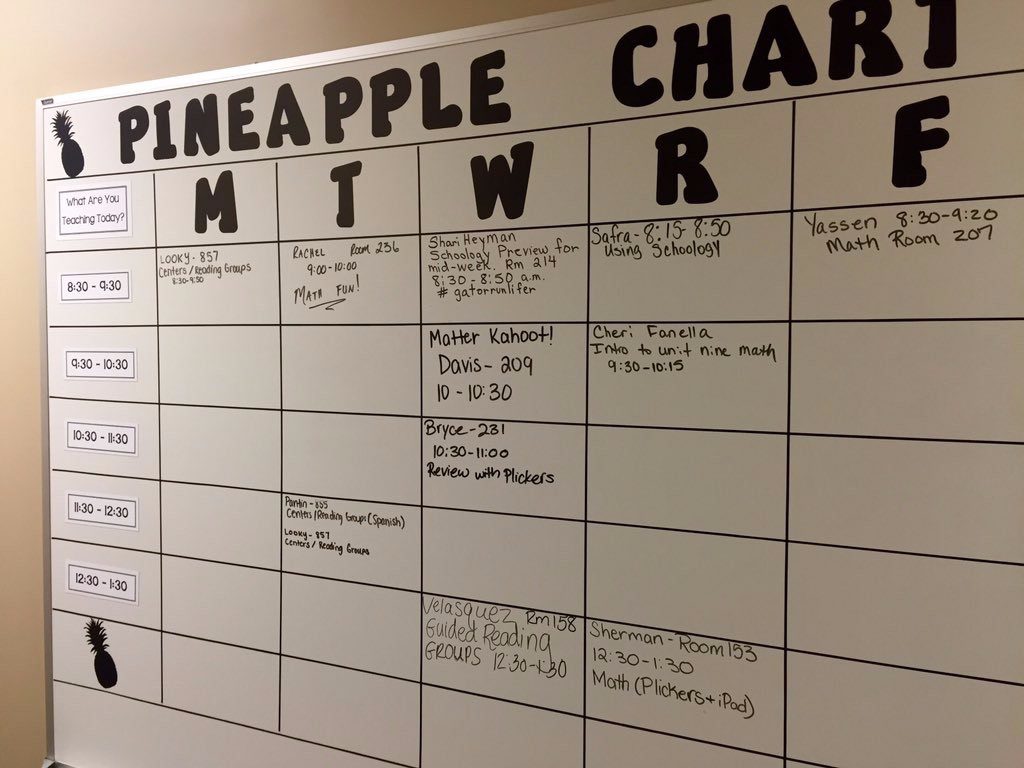
Gator Run’s Pineapple Chart
Gator Run Elementary, Weston, Florida
“The Pineapple Chart has been a game changer for the staff at Gator Run,” says Intern Principal Cyndi Felton, who initiated Gator Run’s first Pineapple Chart in January of 2016. “We have some of the very best PD available under our own roof. Now teachers have the opportunity to get into each other’s classrooms and learn from one another.”
Since the chart has been going, Felton has seen teachers trying new things more quickly. “Last year we noticed tools and strategies spreading throughout the building after Pineapple Chart visits. Kahoot, Nearpod, Plickers, in-class flipped lessons, SeeSaw, and performance scales in addition to unique procedures, classroom management and teaching strategies.”

The Pineapple Chart at Maple Avenue Middle School
Maple Avenue Middle School, Littlestown, Pennsylvania
In January of 2016, when Assistant Principal Cortney Golden first launched the chart in her school, she worked hard to keep it full. “I was very aware that if we lost momentum, and the chart was blank, it would die. I sent staff-wide emails, group emails, personal emails, face to face requests, and even had my secretary appealing to teachers to sign up. Getting teachers to sign up was my first priority….then, once that became more automatic, we began to ‘push’ visiting.”
Since then, informal observation and an open-door policy have become part of the school’s culture. So much so that the word “pineappling” has become a verb:
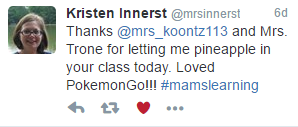
“Collectively, we embrace pineappling now more than ever,” says Golden. “As teachers desire to grow their craft, to foster 21st century skills, and to help students discover and pursue their passions, it becomes clear to all that teachers need each other. Pineappling gives teachers the permission they feel they need to collaborate, observe, ask, and reflect. It is a ‘safe’ and powerful professional development opportunity. Pineappling is free, fits within the school day, and has proven to be the BEST professional growth experience.”
Tips for Making Pineapple Charts Work
Find creative ways to make the time.
The simplest way to squeeze these visits in is for teachers to do them during their planning time, or part of it. Remember, we’re not talking about a whole class period necessarily; a 15-minute visit may be all that’s needed to pick up a new strategy. In cases where teachers want to see something that doesn’t coincide with planning time, the staff will need to be more creative:
- A floating sub can be arranged for a day (or a few days) and teachers can “sign up for the sub” in order to visit another room.
- Administrators (or other certified personnel) can step in to cover a class. This solution does double-duty, as it gives the principal some time to interact more closely with small groups of students. Instead of covering the teacher’s regular material, the administrator could use this time for having discussions about school issues or just getting to know the students.
- Teachers can team up to cover each other’s classes. Imagine a scenario where teacher A agrees to cover teacher B’s class while teacher B observes in teacher C’s room. Then everyone switches roles two more times. A motivated school might even experiment with a second chart (beside the Pineapple Chart) where teachers post a need for coverage and other teachers sign up to cover for them.
Keep it voluntary.
Administrators, be warned! The quickest way to suck the life out of this initiative is to make it mandatory for all teachers. By keeping visits informal and strictly voluntary (for the host teacher AND the visitor), you’ll ensure that the Pineapple Chart is always seen as a positive thing, a learning opportunity initiated by the teacher.
Skip the documentation.
An equally fast way to drain people’s enthusiasm for visits is to force them to do some kind of write-up afterward. Please don’t turn the chart into another reason to require teachers to document. If they know paperwork is expected of them, they will be far less likely to visit.
Start with the bold and the brave…
When you first launch the Chart, many teachers will be shy about posting lessons. Get things going by having your most extroverted teachers sign up first. If you get a group of 5-10 teachers willing to put themselves out there, this will eventually help others step forward as well.
…but set the bar low.
Make sure teachers know they don’t have to be doing something ‘impressive’ in order to post a lesson to the chart. “The hardest part is getting teachers to understand it doesn’t have to be an extravagant lesson to sign up,” says Felton. “Their everyday strategies and standard procedures can be incredibly helpful to someone who has never seen or thought of it. You really never know what you might learn whether it’s a 5- or a 25-minute visit.”
Sell it.
Especially when you first get started, encourage those who do the observing to share the good things they saw by talking about it in faculty meetings, sharing a compliment on a teacher “brag board” or posting about it online. At Maple Avenue, Golden encouraged teachers to tweet about their experiences using the hashtag #MAMSLearning. “This helped keep the excitement high, and the pressure low,” she says. “Although I still have to harass teachers every once and again (I call it “gently wooing”) to showcase the teaching and learning in their classroom, it has become very much part of our culture.”
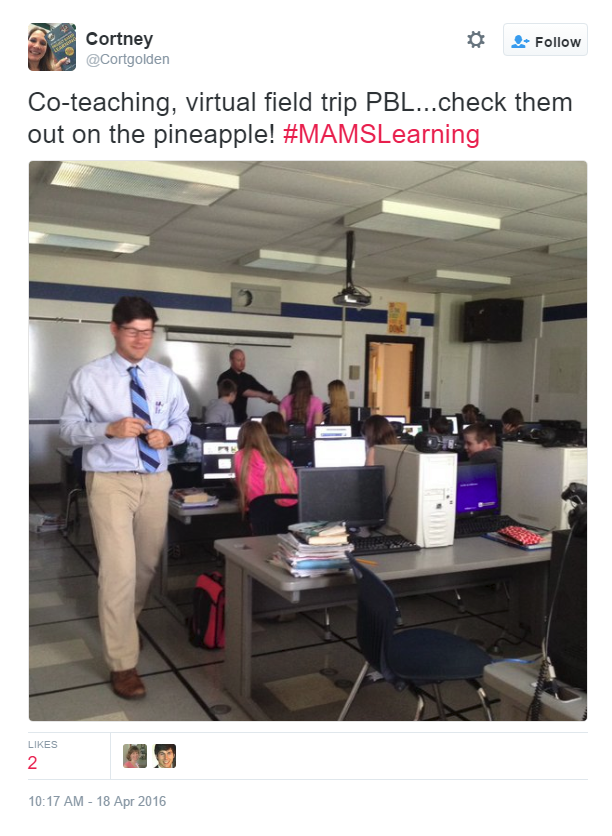
Maple Avenue Assistant Principal Cortney Golden gives Pineapple Chart events extra PR by promoting them on Twitter.
Share Your Story
If your school has already started using a Pineapple Chart, tell us about it in the comments. I would love to hear about tweaks you’ve made to the system and how the system is impacting teacher relationships and student growth.
Learn More
The Pineapple Chart is just one of the 10 hacks Mark Barnes and I share in our 2015 book, Hacking Education: 10 Quick Fixes for Every School. Get your copy today and start hacking tomorrow! ♦
Join my mailing list and get weekly tips, tools, and inspiration all geared toward making your teaching more effective and fun. You’ll also get access to my members-only library of free resources, including my e-booklet, 20 Ways to Cut Your Grading Time in Half, which has helped thousands of teachers spend less time grading!

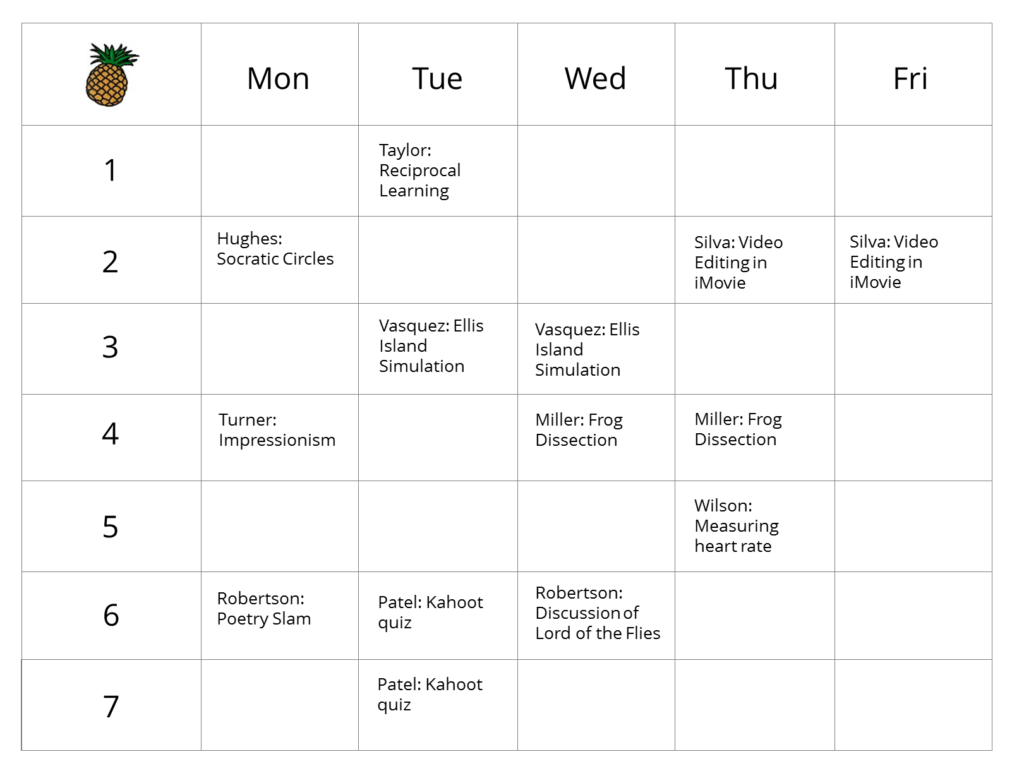





I love this idea! How did you come up with the name “Pineapple” Chart?
Hey Kristin! Read the section called “The Origins of the Pineapple Chart” above.
I’d love to have this opportunity in my school! I’m passing this idea on to the administration. We shall see…
I did a little research on this awesome idea and it looks like they call is the Pineapple Chart because the pineapple is a symbol of hospitality. Totally cute, right?!
Yes, schools are starting to use the pineapple symbol as a sign of welcome. I think most can agree that sharing classrooms is an important part of learning. Interestingly, the pineapple has an historical dichotomy. There is some significance with the pineapple being used as a form of barter/trade, much like the cacao bean in chocolate was used. It was also a symbol of conquering and economic status as it was brought to different countries for its wonderful taste but could only be afforded by the wealthy. The fruit was carved into colonial furniture (like my grandma’s bed posts), and used in decoration on China, linens, etc.
This is genius! Unfortunately it is the OPPOSITE direction my district seems to be taking. I find so many valuable things to direct my instructional practices by reading online, collaborating with online friends and generally seeking out what I find interesting. I love PD and your site is generally my go to starting point! Thanks so much for sharing!
I read this in your book, and I’m so glad for the reminder in your blog. I’ve already sent our PD coordinator an email asking if I can run with this at my school. 🙂 I’ve been in a few classrooms this year in a role as a part time instructional coach, and have already learned a lot, so I think this will be very valuable if people decide to do it.
Wondering if your school found success implementing Pineapple charts. The idea sounds fantastic, and with the young staff at my school, I think there would be a lot of buy-ins. I would add a wanted list next to the calendar for teachers to write down if they are looking for something specific to observe. In my current position, I have the opportunity to go into classrooms every day and see the beautiful things happening, but teachers don’t always understand that the knowledge they have to offer their peers is beneficial. A 4th-grade teacher may be using a technology tool in their classroom with much success and not realize that the 1st-grade teacher on the bottom floor has been struggling to use the same tool in her classroom. I think the Pineapple charts have great potential to open the doors of communication and collaboration for our teachers that feel isolated in their classrooms.
I am very interested in this idea! I’m looking for some personal guidance on the idea of doing this in a high school with around 100 teachers and students on block (90 minute) and house (50 minute) schedules. Would making a pineapple chart per department work? Or is there another way you could envision this? I’m also thinking laminated pineapples on the doors for teachers to make a note of what’s going on inside as a reminder to those passing by to stop in. Thanks for sharing! Looking forward to some helpful hints to get this going in my world.
Hey Jessie! I think you should do one big chart for the whole staff. The number of teachers, I think, would actually make it more successful, because it will give each teacher a much bigger variety of classrooms and techniques to observe. With everyone in the school on different schedules, with different planning times, this will mean more opportunities, and teachers who rarely interact may finally get to know each other!
Any suggestions or has anyone done this virtually? Our music department is spread out over 45 physical sites and getting them the opportunity to visit each other in person is difficult.
Hi, Lisa! You may want to check out this article from Edutopia. Near the end, it addresses how teachers might be able to observe each other virtually.
Also, if you scroll through the comments section, Eric Santos has shared how his school used a Google doc as a digital sign-up. He’s also shared a link to the template that they use.
I hope this helps!
I’m in the process of implementing this at my school. I am just a classroom teacher, but when I brought it to my admin they were pumped about it. I will share more when it takes off (or doesn’t 🙂 )
Hi there Jessie,
I am wanting to launch the pineapple chart here at my campus next month. We are on a 90-minute block with rotating A and B days. Can you share what worked or didn’t work for your campus?
I forwarded this article to my principal and he has asked me to pilot it in the Diploma Programme (which I look after), i.e., Years 11 and 12. Will tell you if it works.
Really great way to structure and encourage peer collaboration and learning. Thanks for sharing.
Absolutely amazing peer learning technique. Pineappling is just cool.
The endless possibilities with this is so inspiring. Great read. How would you adapt this for homeroom teachers like me who work with the early years? I have to be in with my students the whole day, other specialist teachers do pop ‘in’ but I dont get to pop ‘out’.
Hey Ferzine,
I have updated the post to include more suggestions for making time for these visits. Take a look at the first item under “Tips for Making Pineapple Charts Work.” Hope you find something there that helps!
Hi Jennifer! My district has started to explore the “unconference” concept and we are doing building based rounds but I like this even better. How does the teacher who wants to pop into a colleagues classroom get coverage for her class? We don’t have a lot of extra people around the building to cover classrooms.
Hi Barbie!
I have added some more suggestions for making time for these visits. Take a look at the first item under “Tips for Making Pineapple Charts Work.” Hope you find something there that helps!
Thanks for the idea Jennifer. My staff has concerns about not being able to observe grade level colleagues because their schedules are the same. They also feel there is not enough flexibility to see great things if they are happening at times they are not available. How do schools handle flexibility to be able to visit other teachers?
Hey Kristie,
I have added some new information to the original post that might help. Take a look at the first item under “Tips for Making Pineapple Charts Work.”
I love this idea Jennifer!!! I’m a Bilingual/ ESL Coach for McAllen ISD (Texas) and just presented it to the Middle School ELL committee. Teachers love the idea, especially the administrators. I’ll keep you posted and share pictures.
Thank you!!!
I’m wondering how this could be laid out in elementary where everyone has different time slots for different content? 30 min blocks of time?
Hey Tia! Yep, that’s what I would do. And if that ends up not working well, get staff input on what would work better.
I’m an Elementary Principal whose trying to create more of a culture of collaboration and I love this idea! We’ve already promoted “peer pop-ins” by discussing benefits and offering to cover classes but I think this will be a great way for staff to visualize what they will go into see. It also let’s staff know who is willing to be seen. Thank you for sharing this fantastic idea
I adore the flexibility of the observations! Being able to get some work done as I learn from a fellow educator. Awesome!
HI Jennifer,
I’m a principal/director of a small K-12 international school by the mouth of the Amazon in Brazil (Amazon Valley Academy). We have about 85 students and 12 teachers.
With the small number of teachers, how well do you think this would work? I would love for some of our less experienced teachers to glean teaching techniques (or other), from our more experienced teachers. What draws me to pineappling is the hands on learning. Just curious on what you thought.
Thanks!
Hi Rebecca,
I think it would work just fine with a small number of teachers. Granted, there won’t be as much variety in teaching approaches to learn from, but I’d still do it. Good luck with it!
p.s. Your school sounds so interesting!
I appreciate how you defined what informal means. My administration attempted a teacher-teacher observation scheme that was not well received because it was mandatory and micro-managed. The principle (no pun intended) that you need to give up something (control, for example) in order to get something in return is lost on most school administrators I’m afraid.
Jennifer,
I started to write about the Steele Lane License and Curiosity Cards to do something similar to pineapple charts in elementary but it turned into its own blog post. It is here: https://mirrorintoteaching.wordpress.com/2017/02/05/encouraging-growth-mindset-in-teachers-steele-lane-license-and-curiosity-cards/
Jen!
We have a pineapple chart in our school now. And this link was just posted on the Lower School email. See post from earlier (BL Evans). He is my colleague!
Eefonnah!! Is this you, girl? I’m so excited!!
Yikes. I hope it’s you, or I look like a tool.
We put our Pineapple Chart up in the lounge yesterday. Official launch is for next week. Stay tuned! Here’s a pic: https://drive.google.com/file/d/0B_EXQCYkexo-RFhTOTNfZm85LUk/view?usp=sharing
Jennifer,
I love this idea! We started a “pop-in” model this year where staff were encouraged to pop into each other’s rooms unannounced and observe for 10-15 minutes. It improved the culture in the building and worked for a few weeks, but then staff stopped doing it. I love the idea of the pineapple chart though because you, as the teacher, can sign-up on days when you are doing something “interesting” in your room. This ensures that the observer at least has an idea of what they will be seeing. If I want to try something new in my classroom I would love to see it being done in someone else’s room first! I’m going to share this with my principal and see if we can roll this out for the start of next year! Thanks for sharing!
Sarah
Sarah, let me know how it goes! They started it in my kids’ school, but every time I walk past, I don’t see many sign-ups, so I’m curious to find out more about what works in schools where it has really taken off!
We are considering parent volunteers to watch kids while the pineappling happens. This twist means that we need to schedule things much further in advance than one week. Is there any online software that can help manage the scheduling?
After reading up on the ‘origin’ of pineapple I got to wondering where this sentence could be used as people discuss the pineapple chart:
“Some pests that commonly affect pineapple plants are scales, thrips, mites, mealybugs, ants, and symphylids.”
I mean, we’ve all worked with a symphylid…
Personally like the idea of the Pineapple Charts — in my setting we called it the Pineapple Community. As a curriculum coordinator in an international school, I attempted to roll this out in April as our teachers were fulfilling their professional growth goals throughout the school. Our school year goes til end of June so this wasn’t too late in the year. Did not have a lot of interest in the idea from teachers, although we have loads of top-notch teachers.
Perhaps I could have done more to sell the idea. In the first 2 weeks of the initiative we had about 5 teachers participate, but then it fizzled out. Would like to give it another go at the start of next year because I’m convinced it’s an excellent way to promote a professional learning community. I sit in on teachers every year to watch them teach, and am amazed how inspiring my experiences are just observing other teachers do their thing. I’ve always tried to encourage other teachers to observe others in their department, but it’s not always as popular an idea among everyone.
In my own school we had some pineapples made up for teachers to hang on their doors and return to a central area. Had promotion in the daily bulletin and support from our principal and others, but just didn’t take hold as I imagined. Any thoughts by those who have more successfully piloted the idea?
Tuck, did you not have the actual chart for teachers to advertise what they were doing in class? If it was just the pineapples on the doors, that would likely be the cause of the problem.
The idea sounds fantastic, and with the young staff at my school, I think there would be a lot of buy-ins. I would add a wanted list next to the calendar for teachers to write down if they are looking for something specific to observe. In my current position, I have the opportunity to go into classrooms every day and see the beautiful things happening, but teachers don’t always understand that the knowledge they have to offer their peers is beneficial. A 4th-grade teacher may be using a technology tool in their classroom with much success and not realize that the 1st-grade teacher on the bottom floor has been struggling to use the same tool in her classroom. I think the Pineapple charts have great potential to open the doors of communication and collaboration for our teachers that feel isolated in their classrooms.
Hey, Nikki! Really good point. Thanks for sharing!
Wow! This is an amazing idea. I am going to implement this with my team. I love the name pineapple chart. Can I post this idea on my blog with your reference of course.
Hi Humi! This is Debbie, one of the Customer Experience Managers with CoP. Glad to hear you like the pineapple chart and want to post the idea on your blog. That’s totally fine — please just be sure to link back to this article so people know where it came from. Thanks!
Thanks for this article – I will be trying this with our dept next year! Your web site and blogs are fantastic! I will be sharing them with others. Thank you!!!
Michael
PS I just bought your book – “Hacking Education” looking forward to reading it!
Has anyone tried adapting this to a #highered context??
Love this! Making a note to try it this year.
Great stuff here – thank you for sharing. Two things stand out to me:
1. Things ARE changing in regards to Professional Development – and tailoring training to meet school and teacher needs is truly providing meaningful outcomes;
2. The vast majority of great things I did when teaching, I learned from, borrowed, or stole from a co-worker. There’s so much to learn in those classrooms down the hall…
I love this concept, but we are still trying to find ways to encourage teachers to take the risk to be open and post on the board. Any other tips to build on the suggestions in this post?
Hi, Amy! This is Holly, a Customer Experience Manager. You can check out the book Jenn co-wrote called Hacking Education: 3 Quick Fixes for Every School where this idea is published, but you can also check out the hashtag #pineapplechart on Twitter! Many people post a picture of their chart and that’s a way to easily connect with people who have tried it. Hope this helps!
Last March, we implemented pineapple madness. Departments competed bracket style to get the most visits. One teacher got so competitive that she got most her department members to visit other classrooms. She would walk the halls on her prep period and visit classrooms with pineapples. She saw so many great things that she actually got disappointed when people didn’t have a pineapple outside their doors!
We incorporated the Pineapple Chart the last two months of school last year. We challenged our teachers to make 50 total visits by the end of the year, and had an amazing response. The last day of school we gave out a pineapple crown and pineapple sunglasses (courtesy of the Party Store) to the teachers who made the most visits.
This year we are bringing it back and teachers keep asking abou tit, but we want to kick it up a notch and focus more on the learning – depth over breadth. We want to ask each teacher to submit a short reflection form after they visit and then we (instructional coaches) will give feedback on the form, but are not totally confident they will buy in. Any suggestions?
Hi Linda! I can appreciate wanting to take it up a notch, but my gut tells me that requiring written reflections will slow visits way down, because teachers don’t have extra time to write them. Either that, or they just won’t do the reflections, and some will feel like they are sneaking into each others’ rooms and disobeying by not doing the required follow-up work. I am so impressed that you got 50 visits done in the last two months of the school year!! My suggestion is that you make written reflections voluntary, and maybe have them share it on some kind of bulletin board or other faculty-facing space, which will encourage other teachers to also post their reflections. But really, I would leave it at that. Bogging them down with paperwork could mess up what’s already a really good thing!
There are male teachers. She/He is more appropriate in writing a blog post about teaching. 🙂
Hey Jason,
Yes, I regularly make an effort to switch genders in my posts; it looks like in this one I only had one “singular” example, so I just went with female this time. I have always felt that “she/he” doesn’t read smoothly, and in the example above, I used “she” over and over again, which would be an aesthetic roller-coaster ride if I used both each time. I appreciate your point, though, so I added a parenthetical note after the first she to give a nod to male teachers who might feel otherwise slighted. Thanks for sharing your thoughts!
Nicely done. Thanks for the suggestions. Continued success.
Recently shared this concept with our pre-tenure teachers and some vets. We framed it as a “Pineapple Revolution,” and like a pineapple, the planting of this seed may take up 24 months to mature; depending on the climate and fertility of the environment. Small steps… but looking forward to the experience. Thanks!!
I appreciate this article. I was in a chat where this term pineapple chart was used and was directed here to better understand! What a great idea!
I’ve included my blog post about our first two-week block of a Pineapple Chart. We received some very positive comments about the process from staff members as well as some ideas as to how to make it run more smoothly in February. As long as we continue to make it accessible for our team, I think that this is one strategy that is really going to make a difference. Loved it!
Hi Paula! This is Holly–I work for Cult of Pedagogy. Thanks for sharing your experience with Pineapple Charts! We’re so happy it went so well.
I’m a little late to this party, but really love this idea. We want to try to make this work but are struggling to come up with a central location that works. A question: has anyone used a “virtual” chart with online sign-ups? My gut tells me a physical meeting spot is ideal, but I’m wondering whether this might work as an alternative. Any experience with a pineapple chart located online????
Katy,
I don’t know of anyone who’s done online pineapple charts; hopefullly someone will jump in and be able to help out, but if not here, you might want to also pose this question on Twitter using #pineapplecharts.
Katy –
I’m thinking of ways to make this electronic at our school, too! As we start implementation of pineapple charts, I want to have a physical board … but then maybe as it becomes more a part of our culture, we can switch over to a digital board which is prominently displayed somewhere… maybe I can even get our App Design class to design a specific app for pineappling! If you do see any cool e-versions of a pineapple chart, I’d be super interested. I’ll post if we figure anything out!
Hi there,
Our school is using all digital via Google Docs. Here’s a link to the doc we use, feel free to make a copy: https://goo.gl/visUGG
We send it out Friday, all staff has “Edit” access (they are Google savvy after 3 years 1:1, so no concerns about people deleting or changing things).
On Monday we re-send it to remind people and show who has signed up.
Eric
Hey, Eric! I work for Cult of Pedagogy as a Customer Experience Manager–thanks for sharing this! It looks great.
I’m curious what other schools are doing to encourage teachers to visit. We have a unique challenge in that many teachers are opening their classrooms, but people aren’t using their prep time to visit classrooms. Any suggestions?
I am a principal and I loooove this idea. I just saw this today, and I’m going to share it with my leadership team on Tuesday when we meet. Thanks so much for sharing this idea. I believe that we all improve when we bring each other up with us!
Hello. I really appreciate the article. I was wondering why you choose to use a physical chart as opposed to a google calendar or sheet that people could all access from anywhere in the building. As in, these days I don’t visit the office all that often, but I’m on my computer for much of the day (like…now). I’m not challenging the pineapple chart just wondering what the advantage would be in the way it is currently set up. Thanks!
Hi George, I work for Cult of Pedagogy and asked Jenn about this. Jenn said she chose a physical chart not because it’s necessarily better, but because if you put it up in a physical space where teachers go, they’re more likely to see it, talk about it, and use it, whereas something digital is kind of hidden. That’s really it — just so that people see it more often, rather than having to deliberately go into a device and open it up and look at it. For the most motivated schools, Jenn thinks that it would be even better to have both. Or if a school really wanted to make it digital, maybe they could have a designated screen or monitor where it’s displayed. The main thing is that it’s easily visible all the time, otherwise it’s not likely to get used. Thanks!
My principal is trying to implement this in our building but it hasn’t taken off. Only a few people have put their name on the calendar, including myself. I didn’t have any visits when I did. Any suggestions?
Have you tried some (or all) of the “Tips for Making Pineapple Charts Work” above?
This sounds like a good idea. My problem is we have 4 teachers on staff for our school. We all have the same prep period. The students are in their specials during that time. I don’t see how this would work. 😟
That certainly sounds like a different situation. Wondering if anyone would be available to cover your classes for just a little bit while you got to visit each other?
I made implementing a pineapple chart at my school as my final project for a class. We made it digital because our campus is HUGE. I just made my final presentation to school officials and now have a meeting with the superintendent to see if we can help the other schools in the district implement it! This is such a great tool to promote the collaborative culture on campus.
Thanks for sharing Leslie! So awesome to hear how you’ve been able to successfully implement pineapple charts into your district.
How could I implement something like this at the college level? We don’t have a central meeting place, and many faculty/staff are not tech-savvy, but we have flexible scheduling, and I think this could really grow community.
Hey Steph,
Some schools have implemented digital pineapple charts. If you scroll through the comments, you might get some ideas. Check out the digital pineapple chart shared by Eric Santos – that might be something to try.
My school is pushing for more informal teacher observation like what is described here, and there has been talk about requiring observations during our planning periods a few times a month. There has been some push-back to this idea. The Pineapple Chart could be a solution: It is positive and welcoming. I also appreciate the emphasis on “setting the bar low”–both when it comes to the content of lessons that would be observed and how observers would follow up on the experience. In fact, this expression belies the true power of this method, which is to inspire conversations and connections between colleagues who are too often isolated from each other, and to set in motion the sorts of “baby steps” that lead to a true change in practice. I will definitely share this idea with my administration!
Muy interesante sobre la técnica de la Piña ,nos ayudara a progresar mas en las nuevas forma de poner en practicas forma nuevas de aprendizajes y aprender de otros colega.